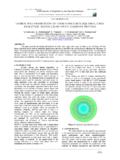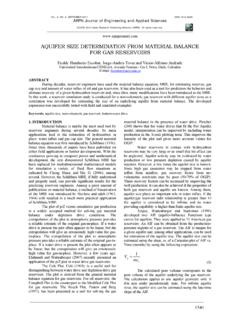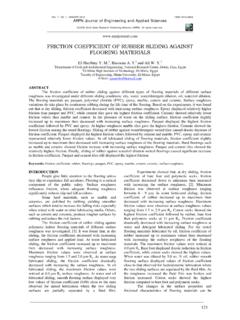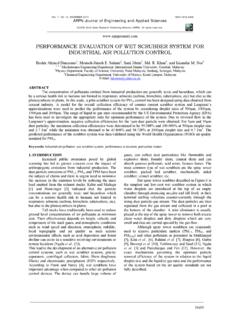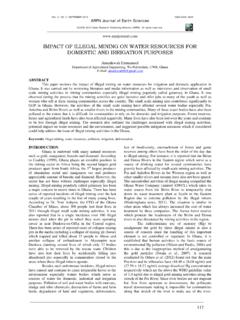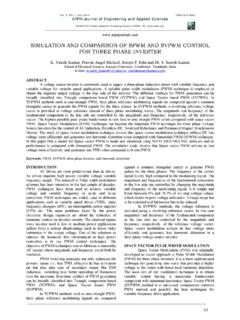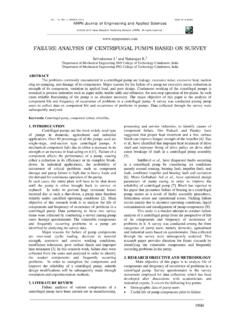Transcription of A study of process parameters of friction stir …
1 VOL. 6, NO. 2, FEBRUARY 2011 ISSN 1819-6608 ARPN Journal of Engineering and Applied Sciences 2006-2011 Asian Research Publishing Network (ARPN). All rights reserved. A study OF process parameters OF friction stir WELDED AA 6061 ALUMINUM ALLOY IN O AND T6 CONDITIONS Indira Rani , Marpu R. and A. C. S. Kumar11 Mechanical Engineering Department, JNTUH CE, Hyderabad, India 2 Materials Section, MTAR Group of Companies, Hyderabad, India E-Mail: ABSTRACT friction stir Welding (FSW) is fairly a recent technique that uses a non consumable rotating welding tool to generate frictional heat and plastic deformation at the welding location while the material is in solid state.
2 The principal advantages are low distortion, absence of melt related defects and high joint strength. Tool design and material plays a vital role in addition to the important parameters like tool rotational speed, welding speed and axial force. The paper focuses on optimization of FSW parameters in different conditions of base material and the microstructures of the as-welded condition are compared with the post weld heat treated microstructures welded in annealed and T6 condition. Keywords: friction stir welding, 6061 aluminum alloy, post welded condition, tool rotational speed, welding speed, axial force, tensile strength. 1. INTRODUCTION Aluminum alloys are important for the fabrication of components and structures which require high strength, low weight or electric current carrying capabilities to meet their service requirements.
3 Among all aluminum alloys, AA 6061 alloy plays major role in the aerospace industry in which magnesium and silicon are the principal alloying elements. It is widely used in the aerospace applications because it has good formability, weldability, machinabilty, corrosion resistance and good strength compared to other aluminum alloys. When using the conventional arc welding techniques, long butt or lap joints between AA 6061 and other aluminum alloys are particularly difficult to make without distortion because of high thermal conductivity and special welding procedures and high levels of welder skill are generally required. The more specialist laser and electron beam techniques can overcome the weld distortion and skill problems, but tracking of very long butt joints is difficult.
4 Moreover, all fusion techniques can cause loss of alloying elements through evaporation and often these have to be replaced by the addition of special filler material to achieve welds which satisfy service requirements. Furthermore, some aluminum alloys cannot be fusion welded. Fusion welding of aluminum alloys poses certain problems like porosity, distortion due to high thermal conductivity and solidification shrinkage. AA 6061 Aluminum alloy cannot be TIG welded without filler wire because it leads to solidification cracking due to its chemistry. In the present work an attempt is made to study the feasibility of joining AA6061 aluminum alloy by friction stir welding (FSW) technique.
5 friction stir Welding (FSW) developed in the year 1991 at The Welding Institute (TWI) in UK is a solid state joining process , meaning there is no melting involved in joining the two work pieces and is used for joining aluminum alloys [1-6]. friction stir Welding can be used to produce butt, corner, lap T, spot, fillet, and hem joints, as well as to weld hollow objects, such as tanks and tubes/pipes, stock with different thickness, tapered sections and parts with 3-Dimensional contours [7-11]. The technique can produce joints utilizing equipment based on traditional machine tool technologies, and it has been used to weld a variety of similar and dissimilar alloys. Replacement of fastened joints with friction stir welded joints can lead to significant weight and cost savings, attractive propositions for many Industries.
6 In this process , a specially designed tool rotates and traverses along the joint line, creating frictional heating that softens a column of material underneath the tool. The softened material flows around the tool through extensive plastic deformation and is consolidated behind the tool to form a solid-state continuous joint. As the FSW process does not release toxic acids or fumes, it is an environment protective process . No consumable filler material or edge preparation is normally necessary. The distortion is significantly less than that caused by arc fusion welding techniques. By welding Aluminum alloys by fusion welding process there is possibility of cracks, porosity, alloy segregation and hot cracking and the fusion welding process completely alters microstructure and varies the mechanical properties [3].
7 By FSW both similar and dissimilar materials can be successfully joined. The mechanical properties of the alloys are affected not only by their chemical composition but also by their condition, annealed, cold worked, precipitation hardened. The work pieces are secured against the vertical, longitudinal and lateral forces, which will try to lift them and push them apart during the process . Figure-1 illustrates the salient features of the process which operates by generating frictional heat between a rotating tool and the work piece, to plasticize the abutting weld region. Commonly the tool is shaped with a large diameter with shoulder and a small varying diameter, specially profiled probe that makes contact first as it is plunged into the joint region.
8 61 VOL. 6, NO. 2, FEBRUARY 2011 ISSN 1819-6608 ARPN Journal of Engineering and Applied Sciences 2006-2011 Asian Research Publishing Network (ARPN). All rights reserved. Figure-1. friction stir welding with a rotating tool. The depth of penetration is controlled by the length of the probe below the shoulder of the tool. The initial plunging friction contact heats the adjacent metal around the probe as well as a small region of material underneath the probe, but once in contact with the top surface of the job, the shoulder contributes significant additional heat to the weld region.
9 In addition, the contacting shoulder, which can be profiled to provide improved coupling, prevents highly plasticized material from being expelled from the welding region. Once the rotating tool is in position the thermally softened and heat affected region take up a shape corresponding to that of the overall tool geometry. The system divides the weld zone into distinct regions as shown in the Figure-2. The heat-affected region is much wider at the top surface (in contact with the shoulder) and tapers down as the probe diameter reduces. This highly plasticized material provides for some hydrostatic effect as the rotating tool moves along the joint, which helps the plasticized material to flow around the tool.
10 The plasticized weld material then coalesces behind the tool as the tool moves away. Figure-2. friction stir welding principle and microstructure. A Unaffected material, B Heat-affected zone (HAZ), C Thermo-mechanically affected zone (TMAZ), D Weld nugget (Part of TMAZ) The tool has two primary functions: (a) Localized heating, and (b) material flow. In the initial stage of tool plunge, the heating results primarily from the friction between pin and work piece. Additional heating results from deformation of material. The tool is plunged till the shoulder touches the work piece. The friction between the shoulder and work piece results in the biggest component of heating. From heating aspect, the relative size of pin and shoulder is important, and the other design features are not critical.
